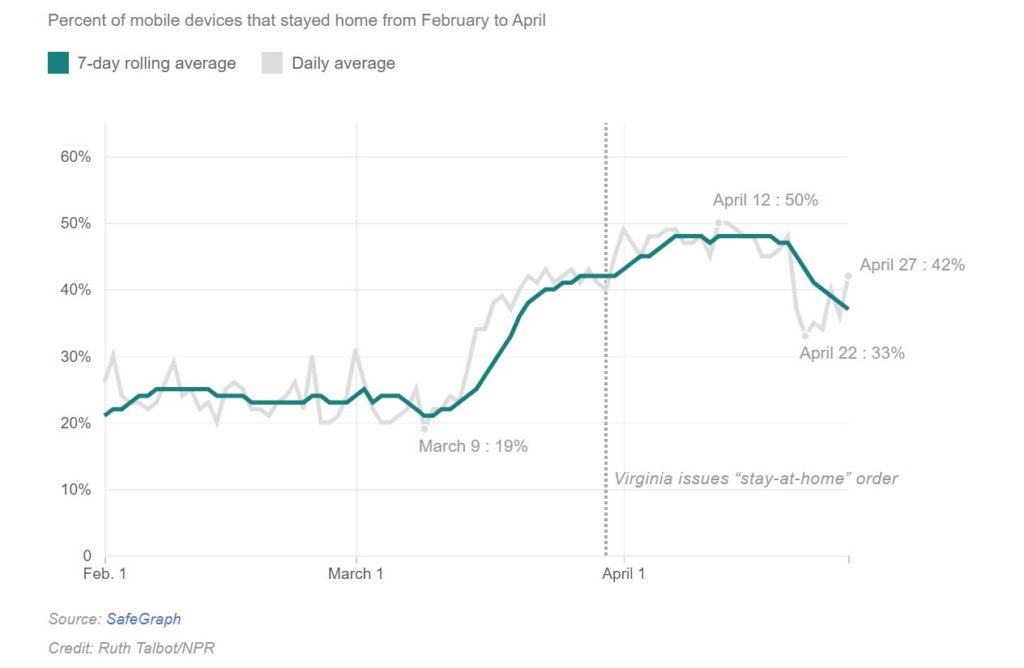Mobile Phone Data Show More Americans Are Leaving Their Homes, Despite Orders

State leaders are considering reopening economies and allowing people to leave their homes, but more and more Americans appear to be doing so on their own.
SEAN MCMINN / RUTH TALBOT
Emerging data suggest that though people dramatically altered their habits to stay at home during the first month of America’s response to the pandemic, that cooperation has since leveled off and — eventually — decreased. This could point to long-term challenges for state governments asking citizens to cooperate with extended stay-at-home policies.
The data, provided to NPR by a mobile phone location data company called SafeGraph, is based on the locations of about 18 million mobile phones across the country. NPR’s analysis determined the percentage of cellphones that did not leave their “home” location daily in every U.S. county.
About 50% of those mobile phones that SafeGraph had data on stayed home on April 12, which was Easter — the highest point in the data. That number hasn’t since come anywhere close, showing a steady decline with the most recent numbers showing that less than 40% stayed home on April 27.
The trend, SafeGraph says, is consistent across the entire country, though the degree to which movement is increasing is different. Some counties showed extreme drop-offs in social distancing, while some showed more mild curves.
“Regardless of what the orders say or the governors say, we’re seeing the whole country softening up,” says Nick Singh, a marketing lead at SafeGraph.
The data provided was anonymized, meaning the locations of exact devices were hidden, with only general trends shown. Companies collecting mobile phone locations have been criticized over privacy concerns, though several have provided their data to researchers during the coronavirus crisis. The data from SafeGraph, which says it tracks only users who have “opted in” via mobile apps, was cited by the Centers for Disease Control and Prevention in an April report on COVID-19.
What these metrics don’t account for is how people practice social distancing when they leave their homes. A picnic in an empty park, for example, would be counted the same as a trip to a crowded grocery store.
A tracker developed by the University of Maryland in cooperation with the U.S. Transportation Department found similar trends. UMD said the change was mostly driven by people going on nonwork trips — not from more people going to work.
Sepehr Ghader, the senior researcher on the UMD project, says it’s too soon to know exactly why people are leaving their homes in larger numbers — though he calls the trend “social distancing fatigue.”
“It might be due to people getting tired of staying at home or it could be due to people reacting to the news that states are being reopened,” Ghader says. “We can’t really say why this trend is happening … but we can certainly see the trend in decrease of social distancing metrics.”
Sharp drop-offs
On April 20 in Arlington County, Va., nearly half of cellphones that SafeGraph provided data for were staying at home. Over the next couple days in that suburb of Washington, D.C., the number declined to one-third — as low as it was during the middle of March. It has since increased but is still down from its peak.
Jim Schwartz, the deputy manager for Arlington County, said the county will have to continue its messaging efforts to keep people at home.
“Enforcement for that is difficult. We’re not in a police state,” he said. “We are trying to encourage people to follow the guidance of our public health officials … I would think that people may be experiencing — in a colloquial term — cabin fever.”
Several of the other counties that had stay-at-home numbers fall off the most are in Texas. Cameron, Comal and Hidalgo counties all saw declines starting around April 6. These counties have not seen especially high death tolls from the disease, indicating there may be some optimism among residents that they can leave their homes with fewer risks. Texas on Friday allowed some businesses to open at reduced capacity.
Esmeralda Guajardo, the health administrator for Cameron County, says news and announcements from the state’s governor and President Trump have sent mixed messages, giving people the impression that it may be OK to not adhere to the shelter-in-place order.
“Anytime there’s some confusion, people are going to take advantage of it.” Guajardo says. “I completely understand the anxiety that people have about staying home. But coming from a public heath perspective, it’s a necessity.”
Meanwhile, the New York City borough of Queens — which has had the highest number of confirmed coronavirus deaths in the city, according to the city’s health department — is one of the places where social distancing appears to have continued. Roughly 60% of people in the SafeGraph sample there stayed at home every day during the month of April, with only a slight decrease near the end of the month.
The path forward
As dozens of states plan to partially reopen, the number of people staying at home will likely decrease further.
Governors who have chosen not to reopen have faced opposition from both residents and leaders in their states. In Michigan, armed protestors entered the state Capitol Thursday demanding an end to Democratic Gov. Gretchen Whitmer’s statewide emergency. In Southern California, two cities said they would go to court to stop Gov. Gavin Newsom, also a Democrat, from closing beaches.
The White House’s own strict social distancing guidelines expired Thursday. Trump is advising states to develop strategies to reopen that would include social distancing measures.
Jason Slotkin contributed to this report.
SOURCE: NPR



